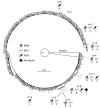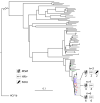Phylogenetic Analysis of Hepatitis C Virus Infections in a Large Belgian Cohort Using Next-Generation Sequencing of Full-Length Genomes
- PMID: 38140632
- PMCID: PMC10747466
- DOI: 10.3390/v15122391
Phylogenetic Analysis of Hepatitis C Virus Infections in a Large Belgian Cohort Using Next-Generation Sequencing of Full-Length Genomes
Abstract
The hepatitis C virus (HCV) epidemic in Western countries is primarily perpetuated by the sub-populations of men who have sex with men (MSM) and people who inject drugs (PWID). Understanding the dynamics of transmission in these communities is crucial for removing the remaining hurdles towards HCV elimination. We sequenced 269 annotated HCV plasma samples using probe enrichment and next-generation sequencing, obtaining 224 open reading frames of HCV (OR497849-OR498072). Maximum likelihood phylogenies were generated on the four most prevalent subtypes in this study (HCV1a, 1b, 3a, 4d) with a subsequent transmission cluster analysis. The highest rate of clustering was observed for HCV4d samples (13/17 (76.47%)). The second highest rate of clustering was observed in HCV1a samples (42/78 (53.85%)) with significant association with HIV-positive MSM. HCV1b and HCV3a had very low rates of clustering (2/83 (2.41%) and (0/29)). The spread of the prevalent subtype HCV1b appears to have been largely curtailed, and we demonstrate the onwards transmission of HCV1a and HCV4d in the HIV-positive MSM population across municipal borders. More systematic data collection and sequencing is needed to allow a better understanding of the HCV transmission among the community of PWID and overcome the remaining barriers for HCV elimination in Belgium.
Keywords: full-genome sequencing; hepatitis c; human immunodeficiency virus; men who have sex with men; next-generation sequencing; people who inject drugs; phylogenetic analysis.
Conflict of interest statement
The authors declare no conflict of interest.
Figures


References
-
- World Health Organization HCV Fact Sheet. [(accessed on 11 August 2022)]. Available online: https://www.who.int/news-room/fact-sheets/detail/hepatitis-c.
-
- Kuo G., Choo Q.L., Alter H.J., Gitnick G.L., Redeker A.G., Purcell R.H., Miyamura T., Dienstag J.L., Alter M.J., Stevens C.E., et al. An Assay for Circulating Antibodies to a Major Etiologic Virus of Human Non-A, Non-B Hepatitis. Science. 1989;244:362–364. doi: 10.1126/science.2496467. - DOI - PubMed
-
- Busschots D., Kremer C., Koc Ö.M., Heyens L., Bielen R., Apers L., Florence E., Messiaen P., Van Laethem K., Van Wijngaerden E., et al. The Hepatitis C Cascade of Care in the Belgian HIV Population: One Step Closer to Elimination. Int. J. Infect. Dis. 2021;105:217–223. doi: 10.1016/j.ijid.2021.02.068. - DOI - PubMed
-
- Busschots D., Kremer C., Bielen R., Koc Ö.M., Heyens L., Dercon E., Verrando R., Windelinckx T., Maertens G., Bourgeois S., et al. Identification and Treatment of Viral Hepatitis C in Persons Who Use Drugs: A Prospective, Multicenter Outreach Study in Flanders, Belgium. Harm. Reduct. J. 2021;18:54. doi: 10.1186/s12954-021-00502-7. - DOI - PMC - PubMed
MeSH terms
Grants and funding
LinkOut - more resources
Full Text Sources
Medical

